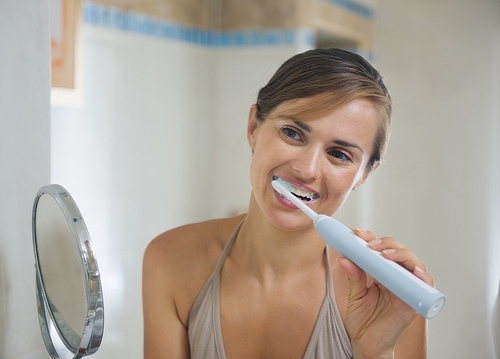Can You Stop a Cavity Before It Starts?
May 28th, 2024

You’re busy getting ready for your day, and of course you’re starting your day off right by looking after your dental health. A two-minute brushing, some careful flossing, and—wait, is that a white spot on your tooth?
If your mirror reveals a patch of white on your enamel, it could be a symptom of early tooth decay. Does this mean a cavity is necessarily in your future? Perhaps not, if you act promptly to reverse the damage!
Cavities, after all, don’t suddenly appear in our mouths. Tooth decay is a process, and it begins with a weak area in the enamel that often appears as a white spot on the tooth. These weak spots are known as “incipient cavities,” because they can easily become cavities if left untreated.
Why do these weak spots occur? And how can we repair them? Let’s look at some tooth science.
- Demineralization
Your tooth enamel is one of the marvels of the human body. Enamel is mostly made of calcium and phosphate ions, minerals which combine to form hydroxyapatite crystals. These crystals create a substance so strong that tooth enamel is the hardest part of the body—harder even than bones.
But it’s not indestructible! If you don’t care for your teeth with regular brushing and flossing, you’re leaving your enamel open to attack.
The bacteria in plaque convert the nutrients they get from the food we eat—especially sugars—into acids. These acids strip away the calcium and phosphate minerals which are the building blocks of our enamel, weakening the surface of the tooth.
Over time, these weak spots get bigger and deeper as bacteria and acids continue to attack the tooth surface. Eventually, cavities form, damaging the enamel surface, and, over time, even reaching into the dentin and the pulp inside the tooth. Once a cavity has formed, you need dental treatment to clean away the decay and repair the tooth structure.
The good news is that, when caught early, it’s possible to rebuild a weak spot in the tooth enamel before a cavity can fully develop.
- Remineralization
While acids strip minerals from your enamel, your body is also replacing those lost minerals all throughout the day. How does this balancing act take place? With the help of saliva.
The very minerals which acids strip from your enamel are found in saliva. Saliva bathes your teeth with calcium and phosphate ions which, in turn, bond with your enamel to rebuild and restore enamel strength. When missing minerals are replaced like this, it’s called remineralization.
But this careful balance of demineralization/remineralization can become upset. If you neglect brushing and flossing, for example, plaque buildup will increase the amount of acids your teeth are exposed to. This means that your body won’t be able to replace the minerals as quickly as they are stripped away, and the result is a white patch on your tooth where the enamel has lost mineral strength.
If you’re surprised by the appearance of a white spot on your tooth, it’s a good idea to visit our Michigan Center, MI office for a diagnosis. If the spot is caused by an incipient cavity, Dr. Timm can provide you with some options to restore your enamel’s strength.
Fluoride toothpastes and fluoride treatments are some of the most efficient ways to remineralize your teeth. Fluoride is attracted to the minerals in your enamel. It bonds with the tooth surface, and, once there, it helps attract the calcium and phosphate ions in your saliva to restore lost minerals and repair weak spots.
But fluoride does more than just restore your tooth’s strength—it improves it! Fluoride ions join with the calcium and phosphate minerals in your teeth to form fluorapatite crystals, which are even larger and stronger than hydroxyapatite crystals.
Early treatment is your best opportunity to reverse the early stages of tooth decay. Keeping up with your brushing and flossing, eating a dental-healthy diet, seeing Dr. Timm regularly, and treating incipient cavities promptly will help ensure there are no unwelcome surprises in the mirror—just beautiful, healthy smiles!



